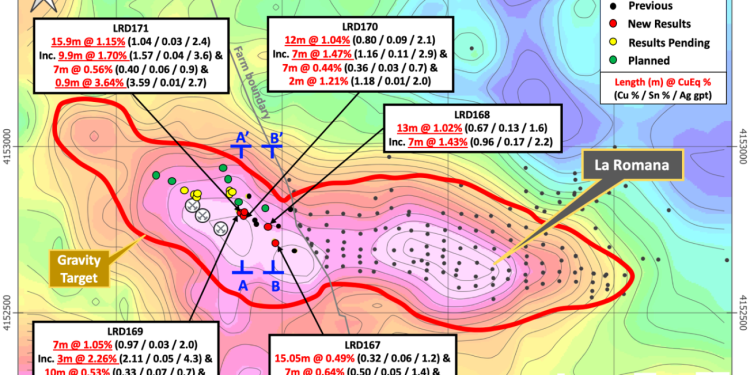Pan Global Resources Inc. (TSXV: PGZ | OTCQX: PGZFF) has announced the intersection of additional high-grade near-surface copper mineralization at the company’s 100% owned Escacena Project in the Iberian Pyrite Belt in southern Spain.
Assay results for five new drill holes from the western extension of the La Romana copper-tin-silver discovery confirm the mineralization extends over more than 1.35km of strike and remains open. These drill results include the highest grades intersected to-date in the current 25-hole drill programme aimed at testing the western extension of the La Romana mineralization.
Tim Moody, president, and CEO, commented, “It is very encouraging that our ongoing drill programme at La Romana confirms extensions to the high-grade copper-tin mineralization. The potential to expand the high-grade mineralization further along-strike to the west and down-dip is exciting. The east-west strike length of La Romana is now more than 1.35km and remains open, with step-out drilling ongoing.”
Highlights include:
- LRD171: 15.9m at 1.15% CuEq1 (1.04% Cu, 0.03% Sn, 2.4 g/t Ag) from 79m, including 9.9m at 1.70% CuEq (1.57% Cu, 0.04% Sn, 3.6 g/t Ag)
- LRD170: 12m at 1.04 % CuEq1 (0.80% Cu, 0.09% Sn, 2.1 g/t Ag) from 61m, including 7m at 1.47% CuEq (1.16% Cu, 0.11% Sn, 2.9 g/t Ag)
- LRD168: 13m at 1.02% CuEq1 (0.67 % Cu, 0.13% Sn, 1.6 g/t Ag) from 52m, including 7m at 1.43% CuEq (0.96% Cu, 0.17% Sn, 2.2 g/t Ag)
- A down-hole electromagnetic (DHEM) conductor anomaly from LRD171 provides a strong indication the higher-grade mineralization continues down-dip and will be targeted for future drilling
“The combination of continuous near-surface copper-tin mineralization, simple and predictable geometry, and favourable metallurgy are significant advantages for potential open-pit development at La Romana. The C$6M non-brokered private placement financing that closed earlier this week puts us in a strong position to fund a multi-target exploration programme and maiden resource for La Romana.”
The main La Romana copper mineralization occurs in two highly continuous layers, Zone B, and Zone C, commencing from surface or directly below a thin cover of post-mineral sediments. The new results show the copper mineralization in Zone B is increasing in grade and thickness in the west. A deeper high-grade copper layer, Zone D, is also present in several recent drill holes, and represents an additional prospective target horizon.
To find out more, please visit www.panglobalresources.com
To read more articles like this, please visit www.theassay.com/news












